Wine Market Size
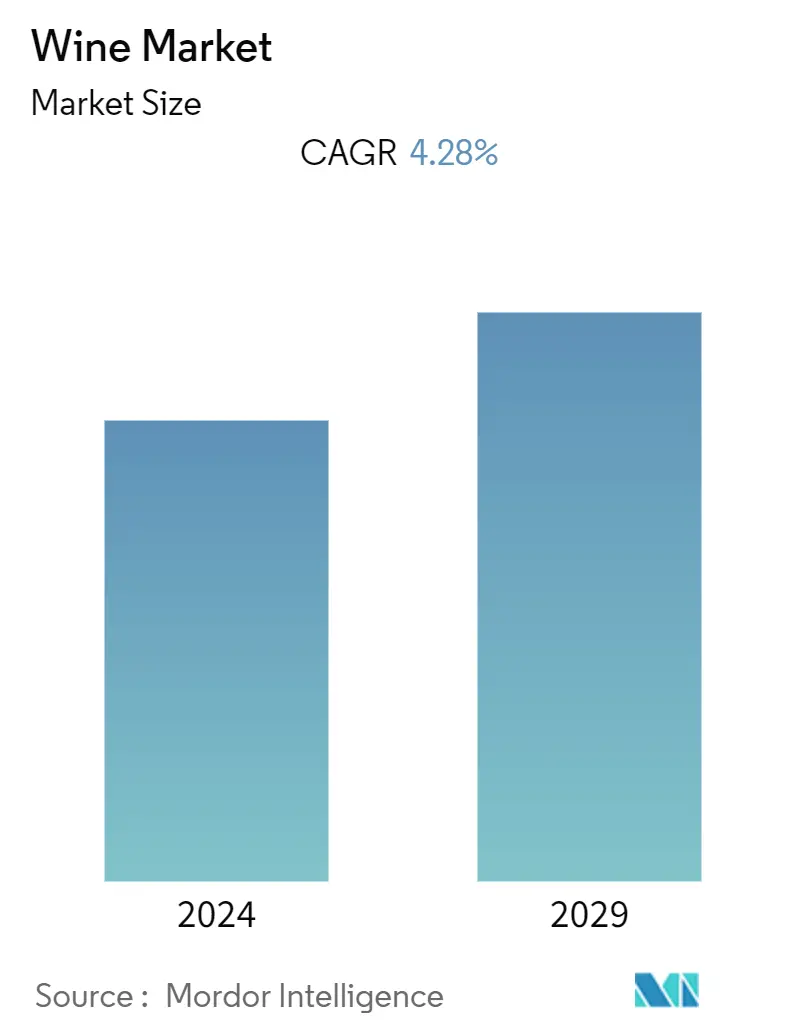
| Study Period | 2019 - 2029 |
| Base Year For Estimation | 2023 |
| CAGR (2024 - 2029) | 4.28 % |
| Fastest Growing Market | Asia Pacific |
| Largest Market | Europe |
| Market Concentration | Low |
Major Players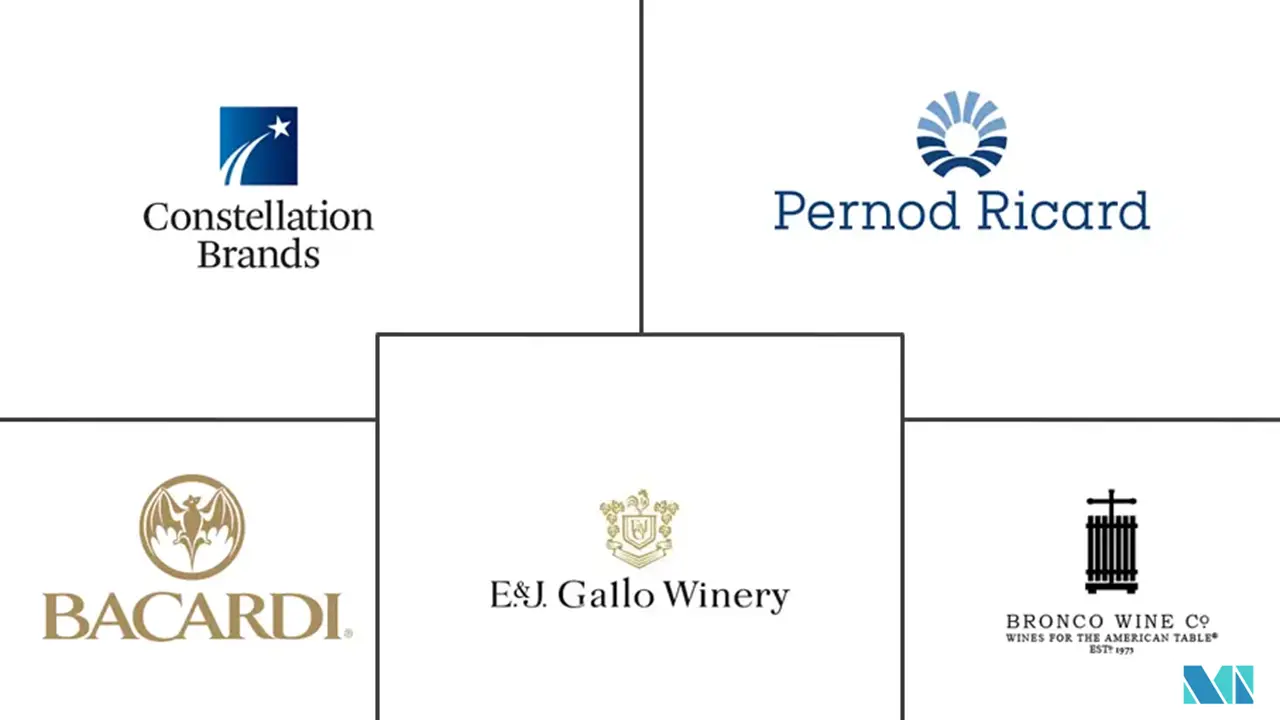
*Disclaimer: Major Players sorted in no particular order |
Wine Market Analysis
The Wine Market is expected to register a CAGR of 4.28% during the forecast period.
The COVID-19 pandemic had a major impact on the wine industry due to the forced closure of on-trade wineries in various countries, such as the United States, the United Kingdom, and India, to control the spread of the virus. However, the current situation may allow the wine industry to recapture lost consumer attention. As per the analysis, the total wine volumes are increasing Y-o-Y as more people are purchasing wine to enjoy with meals at home, majorly in European and North American countries. On the other hand, there is uncertainty about the current boom in the market and off-trade continuing after pantry loading depletes, the on-trade slowly reopens, and consumption behavior returns to pre-COVID-19 levels.
The wine market is likely to be driven by the increasing demand due to its health benefits and premiumization of wine products, coupled with flavor innovation and more advanced distribution networks globally. Due to government policies and new rules and regulations like the legalization of cannabis in the United States and Canada, new flavors are being infused in wines, attracting consumer attention. Changing tastes and new preferences among consumers and increasing demand for new and exotic flavors, such as Riesling wine and other tropical fruit wines, are expected to fuel the growth of the wine market in the future. The market players are forming acquisitions for better market share. For instance, in October 2022, Pernord Ricard announced a partnership with Sovereign Brands to strengthen its portfoilo of luxury wines and spirits
Wine Market Trends
Surging Demand for Fortified and Other Premium Ingredients Infused Wine
Product premiumization is one of the prime factors expected to fuel the growth of the fortified wine market in the coming years. Leading market players are concentrating on the development of new flavored fortified wines to cater to changing consumer preferences. Marijuana-infused wines are gaining high popularity, specifically in markets like the United States. It is possibly the most significant trend influencing the alcoholic drinks market globally. Markets worldwide witnessed consumers shifting toward higher-value products, primarily across a wide range of categories. This trend is prominent in developed markets like the United States. Consumers are keen to explore unique and interesting alcoholic beverages.
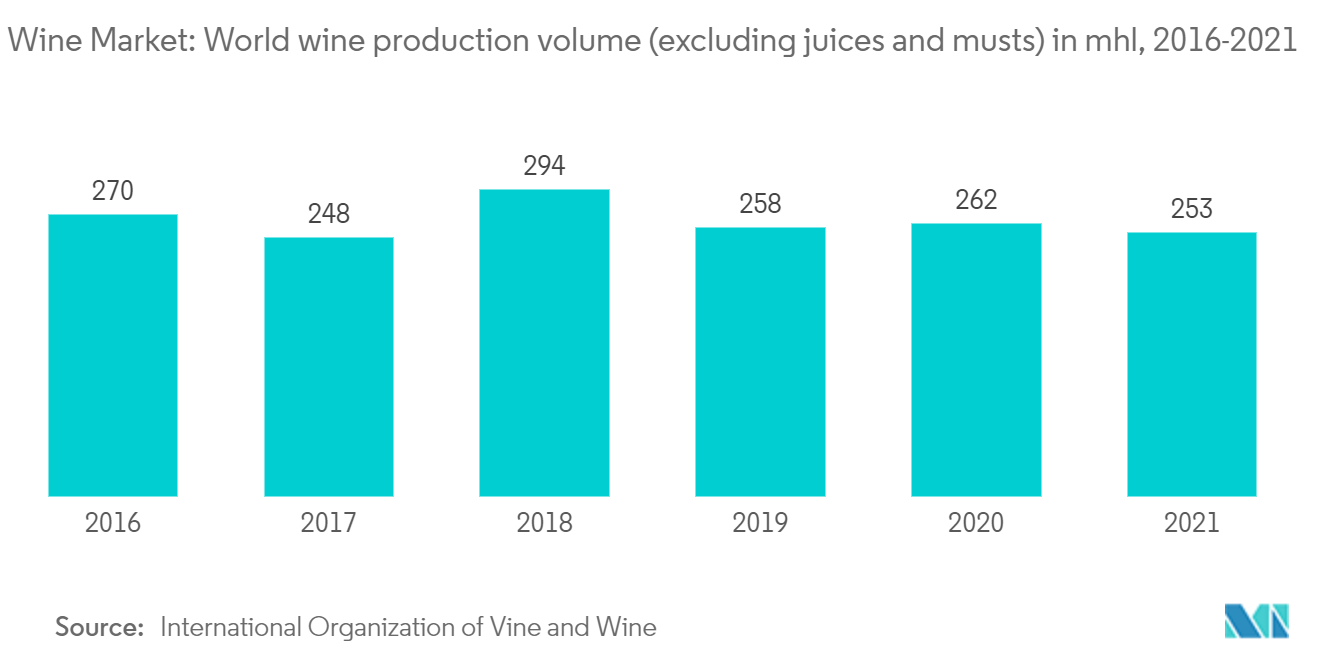
A Surge in Wine Consumption in Asia-Pacific and South America
Asia-Pacific is leading the demand for wine, with China dominating the market in the region. Notably, the consumption of red wine is more prominent as a tradition in China, as the color red is considered lucky in the country. Therefore, China is one of the leading markets for red wine, giving tough competition to France and Italy. Australia ranks second in the consumption of wine in Asia-Pacific, followed by Japan. India is also the fastest-growing country in terms of wine consumption and registered a growth rate of approximately 7%. The Philippines, South Korea, and Vietnam are the other potential wine-consuming markets in Asia-Pacific. Hong Kong has no import tax for wine, which is a driving factor for the market. Brazil and Argentina are other key countries reflecting the future growth prospects in the wine market. The two countries are majorly driven by an expanding middle class and marketing campaigns run by major importers, such as Expand Importadora and Interfood Importação, which aim to promote the culture of wine consumption, particularly in Brazil.
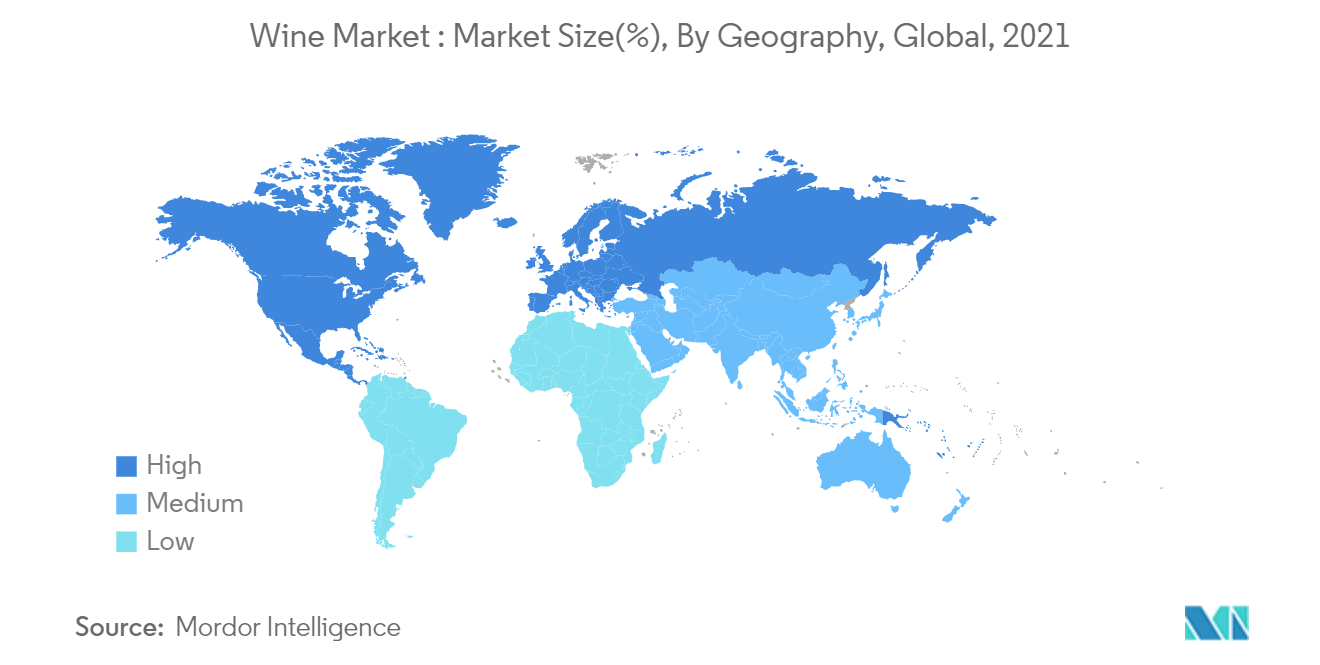
Wine Industry Overview
The wine market is highly competitive in nature due to many global and domestic companies operating in various countries. The prominent companies in the market are E. & J. Gallo Winery, Constellation Brands Inc., and The Wine Group LLC. These companies hold a significant share of the market due to their wide range of wine prices. As every region has several domestic players with robust distribution channels, global players seeking a higher market share prefer to acquire them. Companies are also adopting new product development as another key strategy, as product differentiation helps increase the consumer base.
Wine Market Leaders
-
Bacardi Limited
-
E. & J. Gallo Winery
-
Constellation Brands Inc.
-
Pernod Ricard
-
Bronco Wine Company
*Disclaimer: Major Players sorted in no particular order
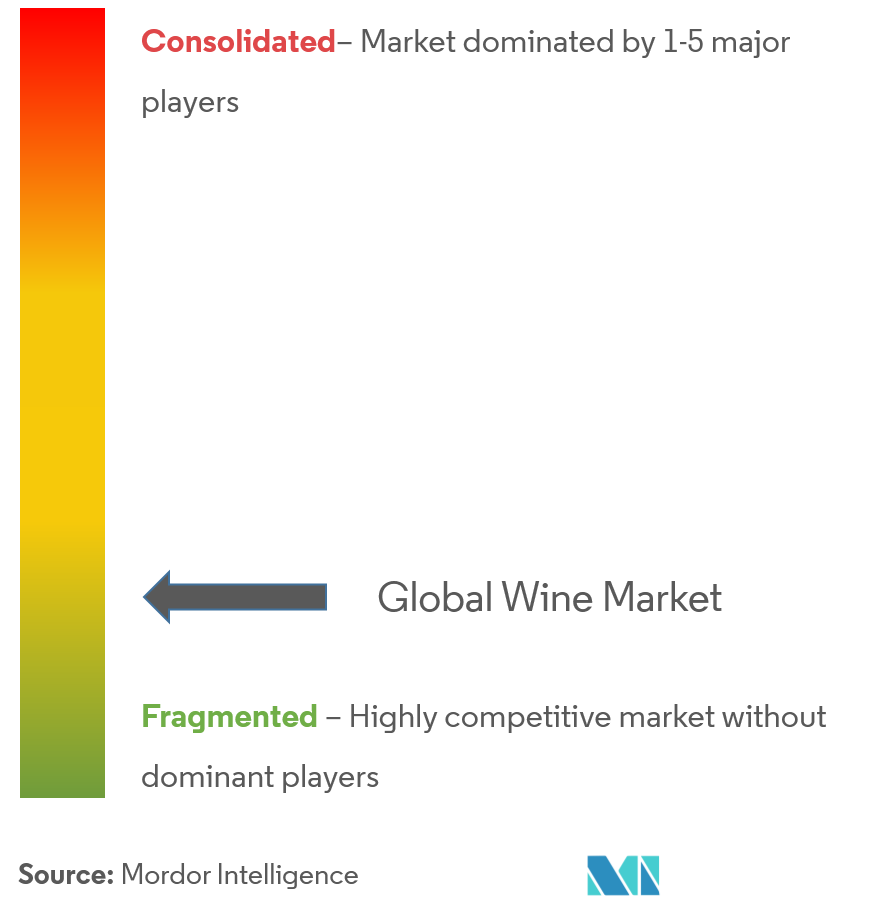
Wine Market News
OCT 2022: Treasury Wine Estates Ltd announced the completion of the acquisition of Château Lanessan, one of the oldest estates in Bordeaux, France. The acquisition is the latest step in strengthening Penfold's multi-regional luxury wine portfolio.
MAR 2022: Pernod Ricard and the Fayard family announced the signing of an agreement for the acquisition of a majority shareholding in Château Sainte Marguerite, Cru Classé Côtes-de-Provence Rosé since 1955, by Pernod Ricard to complete its luxury wines portfolio.
APR 2021: Constellation Brands launched a dedicated business unit for fine wine and craft spirits. The new fine wine and craft spirits include High West Whisky, Casa Noble Tequila, Mi Campo, Copper & Kings, Nelson's Green Brier Distillery, and The Real McCoy.
Wine Market Report - Table of Contents
1. INTRODUCTION
- 1.1 Study Deliverables and Study Assumptions
- 1.2 Scope of the Study
2. RESEARCH METHODOLOGY
3. EXECUTIVE SUMMARY
4. MARKET DYNAMICS
- 4.1 Market Drivers
- 4.2 Market Restraints
-
4.3 Industry Attractiveness - Porter's Five Forces Analysis
- 4.3.1 Threat of New Entrants
- 4.3.2 Bargaining Power of Buyers/Consumers
- 4.3.3 Bargaining Power of Suppliers
- 4.3.4 Threat of Substitute Products
- 4.3.5 Intensity of Competitive Rivalry
5. MARKET SEGMENTATION
-
5.1 Product Type
- 5.1.1 Still Wine
- 5.1.2 Sparkling Wine
- 5.1.3 Fortified Wine and Vermouth
-
5.2 Color
- 5.2.1 Red Wine
- 5.2.2 Rose Wine
- 5.2.3 White Wine
-
5.3 Distribution Channel
- 5.3.1 Supermarkets/Hypermarkets
- 5.3.2 Specialty Stores
- 5.3.3 Online Retailers
- 5.3.4 Other Distribution Channels
-
5.4 Geography
- 5.4.1 North America
- 5.4.1.1 United States
- 5.4.1.2 Canada
- 5.4.1.3 Mexico
- 5.4.1.4 Rest of North America
- 5.4.2 Europe
- 5.4.2.1 Germany
- 5.4.2.2 United Kingdom
- 5.4.2.3 Spain
- 5.4.2.4 France
- 5.4.2.5 Italy
- 5.4.2.6 Russia
- 5.4.2.7 Rest of Europe
- 5.4.3 Asia-Pacific
- 5.4.3.1 China
- 5.4.3.2 Japan
- 5.4.3.3 India
- 5.4.3.4 Australia
- 5.4.3.5 Rest of Asia-Pacific
- 5.4.4 South America
- 5.4.4.1 Brazil
- 5.4.4.2 Argentina
- 5.4.4.3 Rest of South America
- 5.4.5 Middle-East and Africa
- 5.4.5.1 United Arab Emirates
- 5.4.5.2 South Africa
- 5.4.5.3 Rest of Middle-East and Africa
6. COMPETITIVE LANDSCAPE
- 6.1 Most Adopted Strategies
- 6.2 Market Share Analysis
-
6.3 Company Profiles
- 6.3.1 E. & J. Gallo Winery
- 6.3.2 Constellation Brands Inc.
- 6.3.3 The Wine Group LLC
- 6.3.4 Pernod Ricard
- 6.3.5 Lagfin SCA
- 6.3.6 Treasury Wine Estates Limited
- 6.3.7 Bronco Wine Company
- 6.3.8 Foley Family Wines
- 6.3.9 Bacardi Limited
- 6.3.10 Symington Family Estates
- 6.3.11 Madeira Wine Company SA
- *List Not Exhaustive
7. MARKET OPPORTUNITIES AND FUTURE TRENDS
** Subject To AvailablityWine Industry Segmentation
Wine is an alcoholic drink typically made from fermented grape juice. The wine market is segmented by product type, color, distribution channel, and geography. By product type, the market is segmented into still wine, sparkling wine, fortified wine, and vermouth. By color, it is segmented into red wine, rose wine, and white wine. By distribution channel, it is segmented into supermarkets/hypermarkets, specialty stores, online retailers, and other distribution channels. By geography, the market is segmented into North America, Europe, Asia-Pacific, South America, and Middle-East and Africa. For each segment, the market sizing and forecast have been done based on value (in USD million).
| Product Type | Still Wine | |
| Sparkling Wine | ||
| Fortified Wine and Vermouth | ||
| Color | Red Wine | |
| Rose Wine | ||
| White Wine | ||
| Distribution Channel | Supermarkets/Hypermarkets | |
| Specialty Stores | ||
| Online Retailers | ||
| Other Distribution Channels | ||
| Geography | North America | United States |
| Canada | ||
| Mexico | ||
| Rest of North America | ||
| Geography | Europe | Germany |
| United Kingdom | ||
| Spain | ||
| France | ||
| Italy | ||
| Russia | ||
| Rest of Europe | ||
| Geography | Asia-Pacific | China |
| Japan | ||
| India | ||
| Australia | ||
| Rest of Asia-Pacific | ||
| Geography | South America | Brazil |
| Argentina | ||
| Rest of South America | ||
| Geography | Middle-East and Africa | United Arab Emirates |
| South Africa | ||
| Rest of Middle-East and Africa |
Wine Market Research FAQs
What is the current Wine Market size?
The Wine Market is projected to register a CAGR of 4.28% during the forecast period (2024-2029)
Who are the key players in Wine Market?
Bacardi Limited, E. & J. Gallo Winery, Constellation Brands Inc., Pernod Ricard and Bronco Wine Company are the major companies operating in the Wine Market.
Which is the fastest growing region in Wine Market?
Asia Pacific is estimated to grow at the highest CAGR over the forecast period (2024-2029).
Which region has the biggest share in Wine Market?
In 2024, the Europe accounts for the largest market share in Wine Market.
What years does this Wine Market cover?
The report covers the Wine Market historical market size for years: 2019, 2020, 2021, 2022 and 2023. The report also forecasts the Wine Market size for years: 2024, 2025, 2026, 2027, 2028 and 2029.
What are the biggest regulatory challenges facing the Global Wine Industry?
The biggest regulatory challenges in the Global Wine Industry are a) Increasing labeling restrictions b) Growing trade barriers & taxation are urging companies to stay compliant & navigate diverse regulations
Wine Industry Report
The global wine market is driven by the demand for superfood-infused products, rising veganism, and health consciousness. Superfoods, celebrated for their nutrient density, are popular for enhancing health and wellness. The market is shifting towards natural and sustainable products like fruits and vegetables, with online retail channels boosting growth. Additionally, superfood ingredients are being used in cosmetics, attracting eco-conscious consumers. The market, segmented by product type, application, and distribution channel, sees fruits and beverages as leading categories. The Asia-Pacific region is noted for rapid growth due to increased disposable income. Despite challenges, the market offers opportunities for innovation. Statistics for the Wine market share, size, and revenue growth rate, created by Mordor Intelligence™ Industry Reports. Wine analysis includes a market forecast outlook and historical overview. Get a sample of this industry analysis as a free report PDF download.



